This year, the National Retail Federation estimates that 114.6m Americans — more than 50% of the country’s adult population — will participate in Black Friday shopping.

Though many will stick to online sales, millions will still brave the crowds at brick-and-mortar stores, knocking elbows over TVs and holiday toys. To prepare for this retail Armageddon, big-boxers will hire hundreds of thousands of seasonal workers, open at the crack of dawn, and, most importantly, keep the paramedics on speed dial.
Every Black Friday, it seems there is at least one report of a shopper getting injured or killed in some dystopian, chaotic scene at a shopping mall.
But do people actually die because of Black Friday chaos? What are the root causes of reported violent incidents? And what drives this behavior?
To find answers, we analyzed every Black Friday-related death reported in the US between 2006 and 2018.
Deaths and injuries: How many, when, and where?
Our first stop was Black Friday Death Count (BFDC), a site that scrapes Black Friday-related deaths and injuries reported in news headlines around the world. (Note: there are likely many incidents that go unreported each year, so this data is limited in scope).
We filtered out a small number of international incidents (3 in the UK, 2 in Canada, and 1 each in South Africa and Ireland), then read through press coverage to ensure each incident was at least tenuously related to Black Friday.
Here’s what we ended up with:

Over 12 years, we found 44 separate Black Friday-related incidents resulting in 11 deaths and 108 injuries — a relatively small figure, considering that stores saw upwards of a billion Black Friday visits during that period.
This works out to an average of about 1 death and 9 injuries per year. But over time, these accidents don’t seem to have occurred with any degree of consistency.
In 2006 (the first year BFDC found a reported incident), there were 11 injuries; in 2018, with much less retail foot traffic, there were still 7. Some years (2011), there were dozens of incidents; other years (2015), there were none.
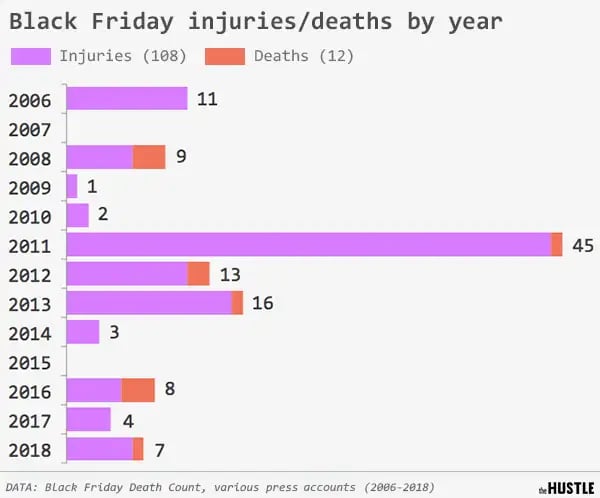
Zachary Crockett / The Hustle
The dramatic spike in 2011 can mostly be attributed to 2 in-store pepper spraying incidents at Walmart.
In North Carolina (a state routinely cited for having the heaviest Black Friday traffic in the country), a police officer “rained” down on an unruly crowd, injuring 20; in California, a woman sprayed fellow shoppers over a Bratz doll in what one patron called “customer-versus-customer shopping rage.”
Outside of these two incidents, deaths and injuries were fairly spread out across the country, with clusters centralized in areas with higher populations, like New York and Texas. In the less-populated Midwest, shopping behavior seemed to be more civilized.
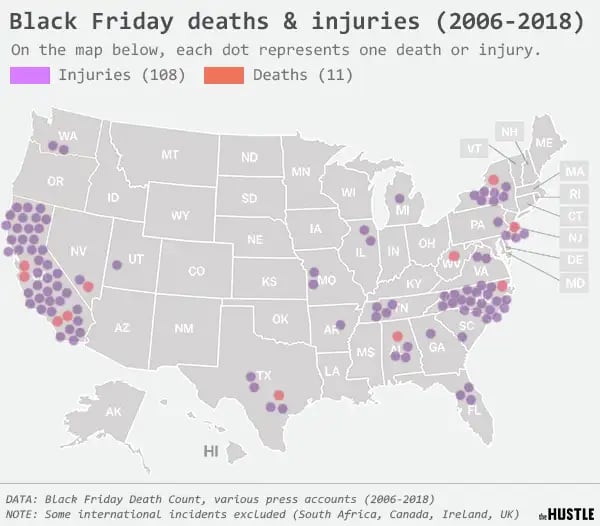
Zachary Crockett / The Hustle
The majority of Black Friday incidents (69%) occur inside of retail stores, where tension can run high as shoppers battle over limited supplies of goods.
About 20% of incidents happen at the store entrance as crowds first pour through the doors, and 11% take place outside a store — either in lots, where customers fight over parking spaces or on the roads after a long day of shopping.
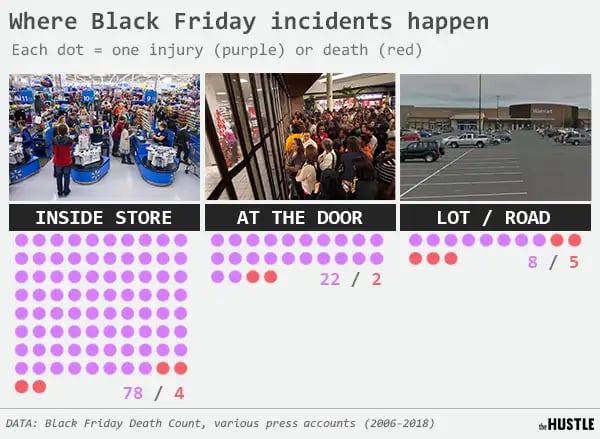
Zachary Crockett / The Hustle
Among in-store incidents, Walmart is in a league of its own.
A whopping 70% of all reported Black Friday-related incidents (and 3 of 11 deaths) occurred at the nation’s largest brick-and-mortar retailer. Especially large crowds can be partly to blame: Walmart received 3.4% of all Black Friday foot traffic in the US in 2018 — nearly double its next competitor, Target (1.8%).
Only 5 other stores (Kohl’s, JCPenney, Toys “R” Us, Target, and Sears) had more than 1 reported death or injury; the rest of the incidents were isolated and spread over a dozen other stores.
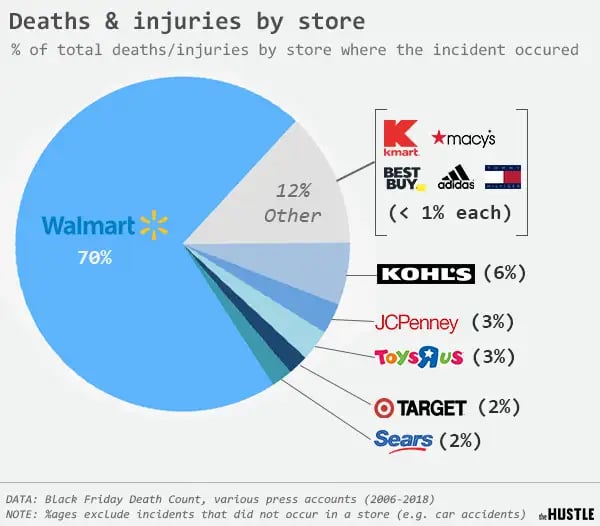
Zachary Crockett / The Hustle
Now that we’ve established where these incidents happened, let’s explore how they happened.
We categorized all 119 incidents by cause — and while some are inextricably tied to the competition and scarcity of items, others stem from the more indirect and general tensions caused by large crowds.
What causes Black Friday mayhem?
The stereotypical Black Friday sale gone wrong includes a stampede induced by thousands of over-eager customers waiting at the entrance of a store.
But injuries and deaths have also been caused by shootings, stabbings, fist-fights, and drivers falling asleep at the wheel after a long day of shopping.
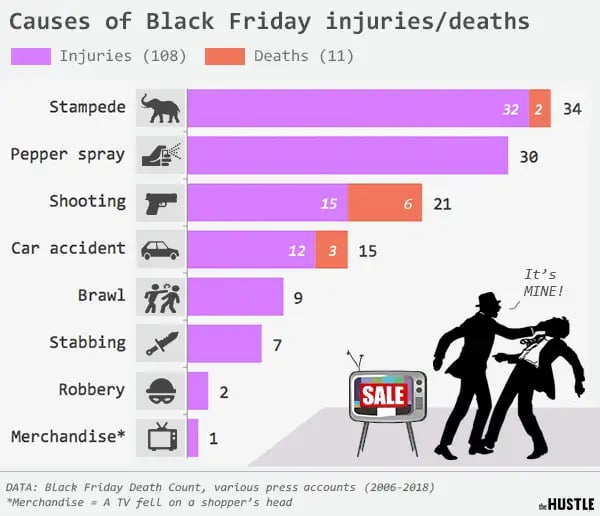
Zachary Crockett / The Hustle
Some stampedes were the result of an in-store promotion gone wrong. In 2006, a shopping mall in Southern California decided to drop 500 gift certificates from the ceiling, into a crowd of 2k; 10 people, including an elderly woman, were injured in the ensuing trampling.
Others, like a 2009 incident where a woman was pinned up against a concrete wall at a Tennessee Toys “R” Us and sustained a head injury, can be blamed on poor crowd management.
“We saw a man and a woman fighting inside over a flat-screen TV,” said one bystander. “This is my first Black Friday and my last. The crowds are pushy and people are downright rude.”
Physical altercations — shootings, stabbings, and brawls — have also been common.
- At a Kmart in Alabama, a brawl over a large toy car landed one man in the hospital with a shattered hip.
- At a Walmart in Virginia, a dispute over a parking spot led to a stabbing.
- At a Chicago-area Kohl’s, a man was shot in the shoulder by a police officer while attempting to steal a TV.
Shootings, it turns out, make up 6 of the 11 reported Black Friday deaths.
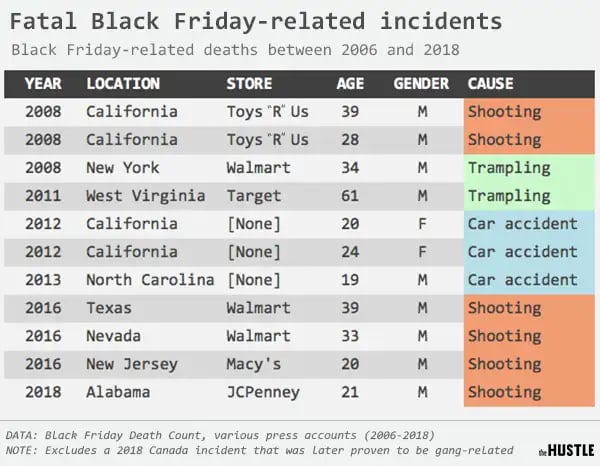
Zachary Crockett / The Hustle
With some shootings, there was a clear link between the act and a shopping-related dispute; others seemed to be fueled by personal conflicts that might have just as easily occurred on any other day.
In Palm Desert, California, two men shot each other to death after their female companions got into a bloody fistfight at a Toys “R” Us. A Texas man was fatally shot in a Walmart lot after intervening in a fight. A man was shot in an apparent dispute over a parking space in Reno, Nevada.
All 3 car accident deaths listed here were the result of the driver falling asleep at the wheel after shopping. Exhausted from an “all-night shopping spree” at an outlet mall, a California man crashed, killing 2 passengers. A North Carolina teen met the same fate.
But perhaps the most well-known Black Friday deaths — and those that can be the most definitively linked to crowds and shopping — are the trampling incidents.
In 2008, a New York Walmart employee was overrun by a crowd of 2k shoppers, who proceeded to stream over his body as he lay on the linoleum floor. “When they were saying they had to leave, that an employee got killed, people were yelling, ‘I’ve been in line since yesterday morning,’” a witness told the AP. “They kept shopping.”
Three years later, at a West Virginia Target, a 61-year-old collapsed and died from a stress-induced heart attack. Shoppers stepped around his fallen body.
Why are shoppers a**holes on Black Friday?
Such behavior begs a question: What causes people to turn into Darwinistic monsters in the face of a good deal?
In a pair of studies (here and here), Sharron Lennon, a professor of apparel merchandising at Indiana University, surveyed hundreds of Black Friday shoppers about their behavior. She found that misbehavior — like rushing the door or brawling over a toy car — stems from “feelings of inequality.”
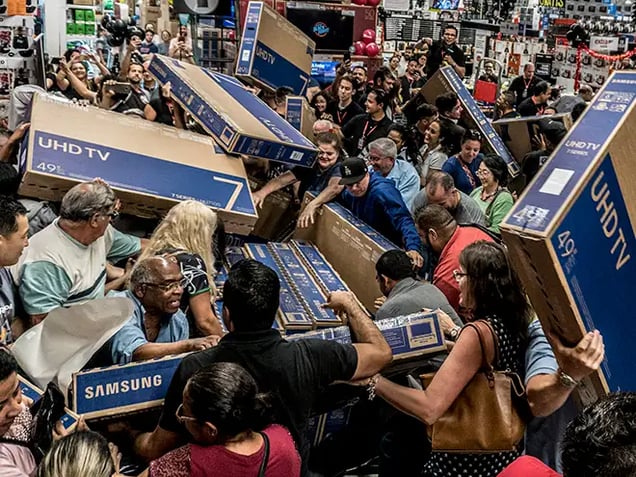
Shoppers fight over TVs at an electronics retailer on Black Friday in 2018 (Cris Faga/NurPhoto via Getty Images)
As she explained to the NYT, when we go to a store, we expect an “equitable” transaction. We hand over money, the store hands over an item.
On Black Friday, the civility of this process goes out the window: We’re lured in with the promise of great deals, but the process of obtaining those deals often isn’t rational or fair. More often than not, the guy who punches an old lady in the face gets the hot Christmas toy over the woman who waited in line for 2 hours in the cold.
But there is a bright side to all of this: This year, for the first time in history, more holiday shopping will be done online than in-store.
The death count for Cyber Monday? Zero.
